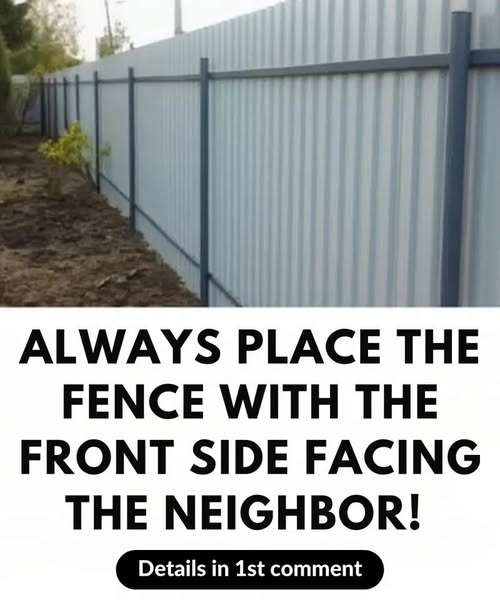When building a fence between your property and your neighbor’s, most people tend to focus on the obvious things—like marking property lines, creating more privacy, or improving overall security. But there’s one small but significant rule that often gets overlooked: always make sure the more attractive, finished side of the fence faces your neighbor.

This isn’t just about good looks or aesthetic choices—it’s a matter of courtesy, legality, and long-term value. By turning the finished side outward, you’re sending a message of respect and good neighborly conduct. It may seem like a minor detail, but the direction your fence faces can set the tone for the relationship you’ll have with those living next to you. When your neighbors see the nice, smooth side of the fence on their end, they’re more likely to feel that you were thoughtful and fair during your home improvement project. On the other hand, if you point the back side of the fence—the one with the posts, rails, or supports—toward their yard, it can come off as inconsiderate or selfish.
Over time, what could have been a peaceful coexistence can turn into frustration and unnecessary conflict. Being intentional about how your fence looks from both sides shows you’re mindful not just of your own space, but of how your actions affect others. It builds goodwill and prevents tension before it starts. But being polite isn’t the only reason to pay attention to this detail. In many neighborhoods and municipalities across the country, local building codes actually require that the finished or “good” side of the fence faces outward. It’s considered standard practice in residential communities, especially those governed by homeowners’ associations. Failing to follow these local guidelines can lead to unexpected consequences, like receiving a notice to remove or rebuild the fence properly. That’s not only frustrating—it can be a costly and time-consuming mistake. So, by planning carefully and understanding your community’s rules ahead of time, you’re saving yourself a potential headache.
In addition to helping with neighbor relations and legal compliance, turning the nice side of your fence outward improves your home’s curb appeal. If your fence is visible from the street or sidewalk, people will judge your property based on how it looks from the outside. A clean, well-finished fence adds to the overall aesthetic of your home, contributing to a neat, well-maintained appearance. This is especially important if you’re planning to sell your home one day—first impressions matter, and prospective buyers will notice details like fence quality and placement. Meanwhile, if the visible side of your fence is rough or full of exposed hardware, it can give off an unkempt or unfinished vibe, which may lower the perceived value of your property.
Some homeowners go the extra mile by installing a “good neighbor fence,” which is designed to look the same on both sides. These fences typically feature symmetrical panels and give both parties an equally attractive view. While this may come at a slightly higher cost, it helps avoid disputes and keeps everyone happy. It also reflects a higher level of care and responsibility when it comes to managing your property. Before you build anything, it’s a good idea to review your town’s building codes and check with your local HOA, if applicable. You might also want to talk with your neighbor about your plans. A quick conversation can avoid misunderstandings down the road. Once your fence is installed, don’t forget that maintenance matters too. A well-maintained fence continues to reflect positively on you and keeps both your yard and your neighbor’s looking neat and welcoming. At the end of the day, making sure the finished side of your fence faces outward is a simple step that goes a long way. It improves neighbor relations, helps you stay in compliance with local laws, boosts your home’s visual appeal, and shows that you care about how your actions impact others. It’s a small gesture with big benefits—and one of the smartest decisions you can make as a homeowner.





